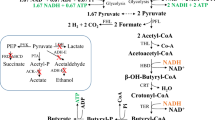Abstract
The penicillin G amidase (PGA) from Alcaligenes faecalis, which has interesting properties for use in combinatorial biochemistry, was produced by recombinant expression in Escherichia coli. The corresponding gene was cloned into a multicopy vector under the strict regulatory control of the rhamnose inducible promoter. Cells were grown in a synthetic minimal medium in a bioreactor (5 l working vol.), and production of PGA was induced by repeated addition of the inducer rhamnose, that served also as a carbon source. The fermentation yield was about 4500 units PGA activity per liter of culture medium.
Similar content being viewed by others
References
Böhm G, Dowden J, Rice DC, Burgess J, Pilard JF, Guilbert B, Haxton A, Hunter RC, Turner NJ, Flitsch SL (1998) A novel linker for the attachment of alcohols to solid supports. Tetrahedron Lett. 39: 3819–3822.
Grether U, Waldmann H (2001) An enzyme-labile safety catch linker for synthesis on a soluble polymeric support. Chem. Eur. J. 7: 959–971.
Haldimann A, Daniels LL, Wanner BL (1998) Use of new methods for construction of tightly regulated arabinose and rhamnose promoter fusions in studies of the Escherichia coli phosphate regulon. J. Bacteriol. 180: 1277–1286.
Ignatova Z, Hornle C, Nurk A, Kasche V (2002) Unusual signal peptide directs penicillin amidase from Escherichia coli to the Tat translocation machinery. Biochem. Biophys. Res. Commun. 291: 146–149.
Ignatova Z, Stoeva S, Galunsky B, Hörnle C, Nurk A, Piotraschke E, Voelter W, Kasche V (1998) Proteolytic processing of penicillin amidase from Alcaligenes faecalis cloned in E. coli yields several active forms. Biotechnol. Lett. 20: 977–982.
Ignatova Z, Taruttis S, Kasche V (2000) Role of the intracellular proteolysis in the production of the periplasmic penicillin amidase in Escherichia coli. Biotechnol. Lett. 22: 1727–1732.
Kasche V, Lummer K, Nurk A, Piotraschke E, Rieks A, Stoeva S, Voelter W (1999) Intramolecular autoproteolysis initiates the maturation of penicillin amidase from Escherichia coli. Biochim. Biophys. Acta 1433: 76–86.
Kutzbach C, Rauenbusch E (1974) Preparation and general properties of crystalline penicillin acylase from Escherichia coli ATCC 11105. Hoppe Seyler's Z. Physiol. Chem. 355: 45–53.
Margolin AL, Svedas VK, Berezin IV (1980) Substrate specificity of penicillin amidase from E. coli. Biochim. Biophys. Acta 616: 283–289.
Shewale JG, Sivaraman H (1989) Penicillin acylase: enzyme production and its application in the manufacture of 6-APA. Process Biochem. 24: 146–154.
Shiloach J, Kaufmann J, Guillard AS, Fass R (1996) Effect of glucose supply strategy on acetate accumulation, growth, and recombinant protein production by Escherichia coli BL21 (?DE3) and Escherichia coli JM109. Biotechnol. Bioeng. 49: 421–428.
Soga T, Ross GA (1999) Simultaneous determination of inorganic anions, organic acids, amino acids and carbohydrates by capillary electrophoresis. J. Chromatogr. 837: 231–239.
Summers D (1998) Timing, self-control and a sense of direction are the secrets of multicopy plasmid stability. Mol. Microbiol. 29: 1137–1145.
Svedas V, Guranda D, van Langen L, van Rantwijk F, Sheldon R (1997) Kinetic study of penicillin acylase from Alcaligenes faecalis. FEBS Lett. 417: 414–418.
Valle F, Balbas P, Merino E, Bolivar F (1991) The role of penicillin amidases in nature and in industry. Trends Biochem. Sci. 16: 36–40.
Verhaert RM, Riemens AM, van der Laan JM, van Duin J, Quax WJ (1997) Molecular cloning and analysis of the gene encoding the thermostable penicillin G acylase from Alcaligenes faecalis. Appl. Environ. Microbiol. 63: 3412–3418.
Wilms B, Hauck A, Reuss M, Syldatk C, Mettes R, Siemann M, Altenbuchner J (2001) High-cell-density fermentation for production of L-N-carbamoylase using an expression system based on the Escherichia coli rhaBAD promoter. Biotechnol. Bioeng. 73: 95–103.
Wilms B, Wiese A, Syldatk C, Mattes R, Altenbuchner J, Pietzsch M (1999) Cloning, nucleotide sequence and expression of a new L-N-carbamoylase gene from Arthrobacter aurescens DSM 3747 in E. coli. J. Biotechnol. 68: 101–113.
Author information
Authors and Affiliations
Corresponding author
Rights and permissions
About this article
Cite this article
Deak, P.M., Lutz-Wahl, S., Bothe, H. et al. Bioreactor cultivation of Escherichia coli for production of recombinant penicillin G amidase from Alcaligenes faecalis . Biotechnology Letters 25, 397–400 (2003). https://doi.org/10.1023/A:1022498314354
Issue Date:
DOI: https://doi.org/10.1023/A:1022498314354




